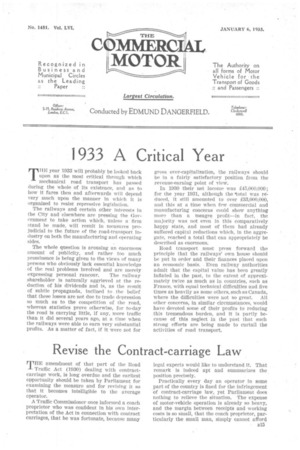Revise the Contract-carriage Law.
Page 29

Page 30

If you've noticed an error in this article please click here to report it so we can fix it.
THE amendment of that part of the Road Traffic Act (1030) dealing with contractcarriage work, is long overdue and the earliest opportunity should be taken by Parliament for examining the measure and for revising it so that it becomes intelligible to the average operator.
A Traffic Commissioner once informed a coach proprietor who was confident in his own interpretation of the Act in connection with contract carriages, that he was fortunate, because many legal experts would like to understand it. That remark is indeed apt and summarizes the _ position precisely.
Practically every day an operator in some part of the country is fined for the infringement of contract-carriage law, yet Parliament does nothing to relieve the situation. The expense of motor-vehicle operation is already so heavy, and the margin between receipts and working costs is so sinall, that the coach proprietor, particularly the small man, simply cannot afford to be involved in costly, and sometimes complicated, court actions.
Ignorance of the law is, in normal 'circumstances, admittedly no defence, but when no one can be sure that his interpretation of legal requirements is correct, it is high time that steps were taken to remedy the matter.
A Traffic Commissioner has endeavoured to assist operators by issuing a statement on contract-carriage -work, but the Commissioners . seem to disagree amongst themselves upon the subject, whilst the definition of a private party is a matter of considerable doubt. When the situation has been cleared up an important move will have been made In the progress of the coaching industry.
The Multiplicity of Traffic Signals
ONEof the best-organized cities, so far as \-,traffic is concerned, is Berlin, where great use is made of light .signals for Its control. Each of these signals constitutes a single piece of mechanism suspended above the centre of the route intersection and showing the appropriate lights on its four faces. Such signals are, from our own experience, far more easily seen, both by drivers and pedestrians, than • are comparatively low posts situated at the sides of the road. They are out of the way of accident, less liable to derangement than are four separate units and should be considerably less expensive in first cost and maintenance. We presume that investigations were _made into the use of traffic lights in various coma-tries, and it would be interesting_ to learn exactly why the system in use in London has been adopted.
Standardization Needed for Bumper Height
BWIPERS are undoubtedly of the utmost -"value in reducing the shocks and damage resulting from minor accidents, and, in fact, they may do a considerable amount towards lessening the force of more severe collisions, but often full advantage is not taken of their use, for the reason that there appears to be no standard of height at which they are fitted. In consequence of this neglect, bumpers, either at the front or rear, accofding to the circumstances, may override those on another vehicle, and not only lose their efficiency in the absorption of shock, but, quite possibly, lock the vehicles together so that there is some difficulty and delay in parting them. The adoption of a uniform ground clearance for bumpers would do much to overcome the difficulty, although this may present a problem when the difference in size of, say, a bus and an Austin Seven is considered, but steps should be taken to render the height as uniform as is possible consistent with fitting facilities. It would obviously be difficult to make alterations in the case of existing vehicles, but with new models the problem would be lessened.




























































































